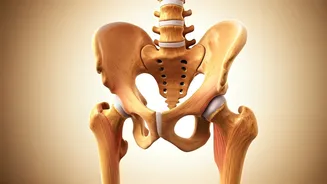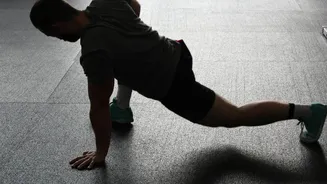Embracing Utkatasana
Utkatasana, commonly known as the Chair Pose, serves as an excellent starting point for any yoga practice. This asana is designed to strengthen your legs
and core while simultaneously stretching your shoulders and chest. To perform Utkatasana, stand with your feet hip-width apart and your arms extended overhead, palms facing each other. Gently bend your knees as if you are about to sit in a chair, keeping your back straight and your core engaged. It's crucial to ensure your knees do not extend past your toes. Hold this pose for a few breaths, feeling the burn in your thighs and the activation in your core. The Chair Pose not only builds physical strength but also cultivates mental discipline, as you learn to hold the pose with intention and focus. Regular practice can significantly improve your balance and stamina, making it a foundational pose for building a robust yoga routine. By understanding and executing the Chair Pose correctly, you establish a strong base for more advanced asanas, enhancing overall fitness and well-being. Proper alignment and conscious breathing are vital, making Utkatasana a perfect blend of physical and mental exercise.
Warrior Pose Benefits
Virabhadrasana II, or Warrior Pose II, is celebrated for its ability to enhance stability and strength, particularly in the legs, arms, and ankles. This pose embodies a stance of power and groundedness, helping to build both physical and mental resilience. To begin, step your feet wide apart, approximately one leg's length, and turn your right foot outward at a 90-degree angle while positioning your left foot slightly inward. Extend your arms to the sides, parallel to the floor, ensuring your palms face downward. Bend your right knee until it is directly above your ankle, maintaining a 90-degree angle, and look over your right hand. Feel the stretch in your groin and inner thighs. Hold the position, focusing on your breath and posture. Warrior Pose II is not just about physical exertion; it’s also about cultivating inner strength and courage. The pose is also beneficial for improving circulation and can assist in relieving stress. With consistent practice, it boosts confidence and enhances overall body awareness, making it a vital component of any yoga practice. Remember to switch sides, practicing the pose on both the left and right, ensuring balanced development of strength and flexibility.
Navasana: Building Core
Navasana, or Boat Pose, is a challenging yet highly beneficial asana aimed at strengthening the core muscles, promoting better balance, and improving digestion. This pose involves sitting on the floor with your knees bent and feet flat, then leaning back slightly while lifting your legs off the floor, keeping your back straight. You can start with your knees bent and shins parallel to the floor, or if you feel strong, extend your legs fully, forming a V-shape with your body. Extend your arms forward parallel to the floor. The key to Navasana is to engage your core muscles to maintain your balance and prevent your back from rounding. This pose not only strengthens the abdominal muscles but also improves flexibility in the spine and hip flexors. By actively engaging the core, Boat Pose helps to improve posture and stability. Furthermore, it energizes the body and mind, promoting a sense of mental clarity and focus. Start with a shorter duration and gradually increase the holding time as your core strength improves. Proper form and consistent practice are essential for maximizing the benefits of this dynamic asana.
Lotus Pose Meditation
Padmasana, or Lotus Pose, paired with meditation, is a powerful combination for deep relaxation and mental clarity. To enter the Lotus Pose, sit on the floor with your legs extended. Gently bend one knee and place your foot on the opposite thigh, as close to the hip as possible. Repeat this with the other leg, placing the other foot on the opposite thigh. Once in the Lotus position, ensure your spine is straight and your hands can rest comfortably on your knees, palms up or down. This pose promotes increased flexibility in the hips and ankles while facilitating a stable base for meditation. By practicing Padmasana, you are preparing your body to remain still for extended periods, reducing distractions during meditation. The deep breathing and stillness associated with meditation enhance focus and calm the mind, fostering a state of tranquility. Combining Padmasana with meditation allows practitioners to deepen their spiritual practice and improve their overall mental well-being. This pairing is a profound way to cultivate inner peace and improve your concentration and overall mental health. Consistent practice will help in becoming more comfortable with both the asana and meditative practice, enabling you to stay mindful for an extended duration.
Sun Salutation for Fitness
Surya Namaskar, or Sun Salutation, is a dynamic sequence of twelve yoga poses seamlessly linked together. It serves as an invigorating warm-up and a complete workout, enhancing strength, flexibility, and coordination. The sequence begins in Tadasana (Mountain Pose), followed by Hasta Uttanasana (Raised Arms Pose), then Uttanasana (Standing Forward Bend). After this, the sequence moves into variations like Adho Mukha Svanasana (Downward-Facing Dog), Bhujangasana (Cobra Pose), and others, moving through a series of bends, stretches, and inversions. Each pose is synchronized with the breath, promoting a harmonious flow and deep connection with the body. Surya Namaskar is not just physical exercise; it's a practice of mindfulness and gratitude. The continuous movement stimulates the cardiovascular system, improves circulation, and builds heat within the body. Regular practice can boost metabolism, reduce stress, and improve overall physical and mental health. This sequence is a great way to start your day, bringing vitality and energy. Practiced regularly, Sun Salutation is an effective pathway to improved health, vitality, and well-being. It helps in warming up the muscles and preparing the body for more complex yoga poses.












